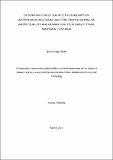| dc.contributor.author | Tesha, Irene | |
| dc.date.accessioned | 2019-05-29T10:12:29Z | |
| dc.date.available | 2019-05-29T10:12:29Z | |
| dc.date.issued | 2018-03 | |
| dc.identifier.uri | https://doi.org/10.58694/20.500.12479/240 | |
| dc.description | A Dissertation submitted in partial fulfillment of the requirements for the Degree of Masters’ in Life Sciences of the Nelson Mandela African Institution of Science and Technology | en_US |
| dc.description.abstract | Water safety is an important aspect in human health as it tends to decrease mobidity and mortality of infectious diseases that affect human populations. Improvements of water handling chains in rapidly urbanizing areas can contribute to inform policy and plans on sanitation and hygiene in these cities of tomorrow. A cross sectional study was conducted to obtain data on water handling and water storage practices done by communities in a northeastern town of Babati, Manyara Region in Tanzania. Using a stratified random sampling technique, water samples were taken from the common sources of water as well as from the downstream points in a given water handling chain. Water samples were collected in triplicate to test for two organisms (faecal coliforms, and Salmonella typhi. Descriptive and analytical tests (t-test and anova) were used to determine whether contamination levels differed among the chains. The main source of drinking water in Babati town is ground water. Five major sources of water were identified and consisted of wells, rivers, ponds, springs and lake. There were 4 reservoirs and 10 distribution points serving the 37 studied households. Three water-handling chains/patterns are characteristic of Babati town and consisted of: untreated source (untrS) to treated reservoir (trR) and finally to households (HH) abbreviated as ‘untrS2trR2HH’; untreated source (untrS) to untreated reservoir (untrR) and finally to households (HH) abbreviated as ‘untrS2untrR2HH’; and untreated source (untrS) straight to households (HH) abbreviated as ‘untrS2HH’. The number of users in these three chains was not statistically different (p = 0.5226) meaning that more or less all people in Babati source their waters from all the chains. The most contaminated chain was the one involving the untreated source to households. Most households (83%) did not treat the water they use for drinking making those using the untreated source to household chain (untrS2HH) most vulnerable to water-borne diseases. Comparison of education and usage of storage containers revealed that people who were educated were also not cleaning their storage container with water (p=0.01). Knowledge of unique water-handling chain from this study is an important tool in understanding the epidemiology and focusing the control of water-borne diseases in Babati town and in similar fast-growing small towns. | en_US |
| dc.language.iso | en_US | en_US |
| dc.publisher | NM-AIST | en_US |
| dc.subject | microbial profiles | en_US |
| dc.subject | water handling chains | en_US |
| dc.title | Determination of source-to-consumption waterhandling chains and their implications on water quality and human health in Babati town, Manyara, Tanzania | en_US |
| dc.type | Thesis | en_US |

